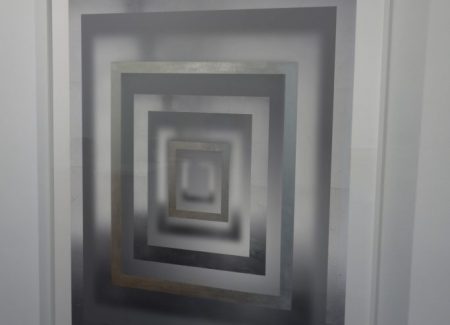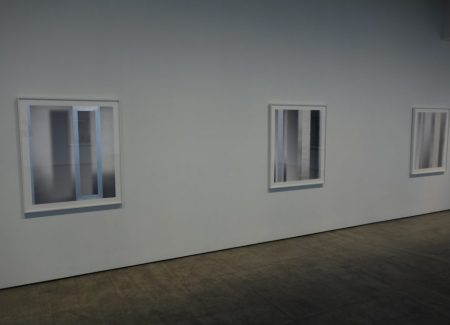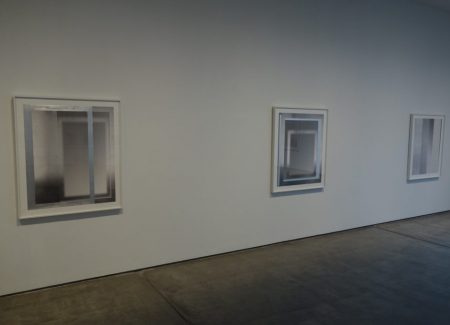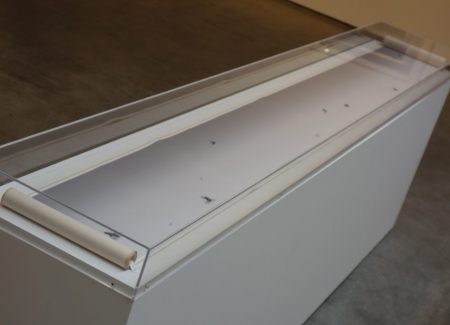JTF (just the facts): A total of 19 photographic works, generally framed in white and unmatted, and hung against white walls in the main gallery space and the entry area. 8 of the works are silver leaf on inkjet paper diptychs, made in 2016 and 2017. Each panel is sized roughly 18×16. 9 of the works are silver leaf on inkjet paper prints, made in 2016 and 2017. Each is sized 42×35. And 2 of the works are silk and archival inkjet print scrolls, mounted on paper in a camphor box (and displayed in vitrines), made in 2010 and 2016. Each is sized 12×150/12×152 and available in an edition of 2+1AP. (Installation shots below.)
Comments/Context: Recursive rephotography is a meticulous technique born in the heady photoconceptualism of the late 1960s and recently rediscovered by many contemporary photographers, particularly those with the logic of software design running through their brains. Its picture-of-a-picture-of-a-picture layering embraces the physicality of the photographic print and uses successive executions of imagery to build up final works. In many cases, these iterations can deliberately lead to head-scratching optical puzzles and illusions, where perspectives change, objects seem to disregard the laws of science, and time sequences are shuffled, all within a single frame.
Bing Wright’s recent works join this rephotography parade, but use the precise approach to explore the nuances of surface. Back in 2010, Wright used silver foil to explore reflection and shadow (reviewed here), and he has reprised some of the ideas he was investigating then in these new works. Silver leaf has intriguing visual properties – it has a delicately imperfect, textured surface and reflects light with subtle flared gradation. Wright has leveraged these characteristics in his new iterative compositional structures, creating flat planes of silver that are then layered into successive rephotographed steps of increasing indistinctness.
The simplest of Wright’s images play with vertical strips, piling up variations of width and light quality into dissolving patterns, with a top layer of actual silver foil adding a crisp frontal shine to the receding layers of blur. Hard edges intermingle with softer echoes that seem to recede into the background like a field of columns, and the shifting tonalities are allowed to play off each other. Other compositions turn the component silver strips into rectangular frames. Here squared off corners offer a different set of compositional options – telescoping, shifting alignment, overlapping, and interlocking – that create alternate geometric patterns. In each, the actual silver and the fuzzy pictures of silver are forced to interact, and this is most effective when the corners jut into each other, confusing our sense of depth and order.
A second group of works uses the changeable surface of the silver foil like a brash veil or screen. Pairs of gentle black and white cherry blossom images are covered with rigid grids of silver squares that obscure the underlying pictures, their graph paper regularity evoking enlarged pixels. The patterns of squares in the diptychs are either reversed (silver in a given quadrant in one picture and the image itself in the equivalent quadrant in the other) or rotated 180 degrees (with the pattern of squares in the upper left moved to the lower right), so each diptych has a sense of connection, either positive/negative or turned around. But even though there is an obvious opposition of floral beauty and machined order in these works, that juxtaposition doesn’t go anywhere particularly intriguing – the silver feels largely decorative, like a sparkly interruption.
In the end, Wright makes the most of the silver foil when he subjects it to the transformations of iterative pictorial layering. It is here that the tactile surfaces and gradations of light become tools for more complex aesthetic experiments, and the shimmery texture can repeatedly break down and reform, the light fading and coalescing in cycles of thoughtful uncertainty.
Collector’s POV: The works in this show are priced as follows. The large single image prints are $18500 each, the smaller diptychs are $12000 each, and the scrolls are $15000 each. Wright’s work has little secondary market history, so gallery retail likely remains the best option for those collectors interested in following up.















A correction: artist site link is bingwright.com, instead of bingwright.net.